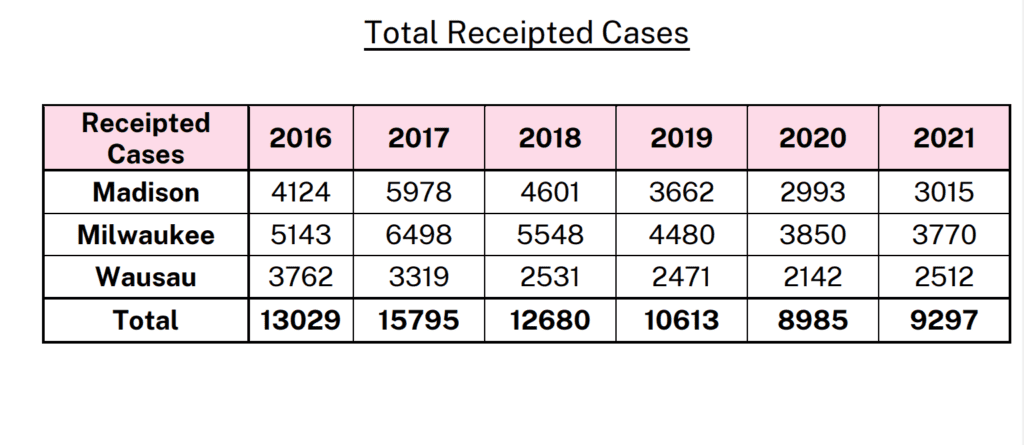A new report issued by AG Josh Kaul shows that former AG Brad Schimel’s crime lab was more productive and effective. Schimel was hammered relentlessly by Kaul and the news media on the topic. Will Kaul get the same scrutiny?
Attorney General Josh Kaul’s crime lab is taking in far fewer cases than his predecessor Brad Schimel even as violent crime skyrockets throughout the state, yet is taking longer to process them in key areas like DNA analysis and controlled substances, Kaul’s own numbers show.
Furthermore, Kaul’s crime lab is taking in almost 30% fewer cases than Schimel did in 2016.
Kaul released the report the Thursday before Easter, which raises the question of whether he was trying to bury the findings. Kaul touted a first-ever crime symposium being held and a new unit devoted to crime scene response. Kaul admits in a throwaway line that “the average turnaround time (TAT) for DNA analysis was up in 2021.”
But “turnaround time” is where the rubber meets the road. Slower processing of evidence leads to slower prosecutions and can result in offenders remaining on the streets longer. Kaul’s own mother, Peg Lautenschlager, learned this the hard way when she was Attorney General, and a delay in processing a DNA sample left an offender on the street who was later accused of being involved in the murder of a state drug agent.

The Democratic Attorney General, who has prioritized partisan fights and a new diversity/equity position as violent crime explodes in the state’s largest city, released the 2021 annual state crime lab report on April 14, 2020. The report shows that, by key measurements, Kaul’s crime lab performed worse in 2021 than it did in his first year in office, which was 2019. Kaul was sworn into office on January 7, 2019.
His annual report left out a direct comparison to Republican Attorney General Schimel, whom Kaul and the media relentessly hammered on the same issue. We did what Kaul did not; we looked up the numbers for Schimel’s last year in office, 2018, and we compared them to Kaul’s 2021 numbers.
See Kaul’s 2021 annual report here: 4.15.21_Annual_Report
In 2021, the crime labs under Kaul handled 9,297 cases. That’s a slight increase from 2020, when the pandemic hit, but it’s a drop from 10,613 cases in 2019, when Kaul took office. In 2016, under Schimel, the crime lab took 13,029 cases. In his last year, in 2018, the crime lab took 12,680 cases.

That’s almost a 30% decrease under Kaul since 2016 under Schimel.
Although Kaul blistered Schimel on the crime lab, by key measurements, he’s managing it MUCH worse, the data, from DOJ reports, shows. For example, in the key area of DNA Analysis, Kaul’s office handled 3,612 cases in 2021, with a mean turnaround time of 128. Schimel’s crime lab handled 8,626; the turnaround time was 80. Some of the additional cases might be explained by a glut of old rape kits being analyzed; however, the fact is that Kaul’s crime lab took in far fewer cases but took more days on average to turn them around.
Another example: In controlled substance cases, Schimel took and completed far more cases than Kaul, but processed them in less time. In 2021, Kaul took in 4,430 cases and the mean turnaround time was 61; Schimel in 2018, took in 5283, and processed them in an average 43.

Trace evidence is another example. His office handled fewer cases in 2021 than in Schimel’s last year and took more time to do it. Latent footwear is one of the only areas where Kaul definitively improved things over Schimel.
Even in cases where Kaul’s turnaround time improved over Schimel’s, it turns out that his office is being FAR LESS productive, even though violent crime has skyrocketed. For example, Schimel’s office took in 1,304 latent print cases and finished 1,706; Kaul, in 2021, took in 1,000, with a case output of 963. Not surprisingly it took Kaul’s analysts less time to process them – they were handling and completing far fewer cases.
Fond du Lac County DA Eric Toney, who is running in the Republican primary for a chance to square off against Kaul, said, “Josh Kaul campaigned on fixing the crime and is trying to bury his abysmal failure of mismanaging the crime lab. Kaul is playing politics with public safety by limiting the amount of evidence prosecutors and cops can submit to the lab in a failed effort to improve his testing turnaround times. Kaul is testing significantly less items than former AG Brad Schimel and is still taking longer to test many categories of key items in comparison to Schimel, including DNA. Wisconsin can’t afford another 4 years of Kaul’s failures.”
In 2018, Kaul slammed Schimel over Wisconsin crime lab backlogs, saying, “I’m glad to see that, in an election year, Brad Schimel has finally found the motivation to take action, but we need an Attorney General who is consistently committed to ensuring that justice isn’t delayed for victims.”
The best positive spin Kaul could come up with in the 2021 report: He’s claiming that there are fewer DNA cases pending in the “queue.” But that’s only because his office has taken in fewer cases.
Kaul admitted in his 2020 report that “the legislature made a significant investment in the crime labs in the last state budget.” Yet he’s still trying to blame staffing this time around.
Kaul has admitted previously that he’s taken actions that artificially reduced the caseloads handled by the crime labs, saying the drops were driven in part by changes his office made to the submission guidelines restricting what law enforcement and prosecutors can send to the Wisconsin crime labs in the first place.
In 2019, Josh Kaul told Wisconsin Public Radio that one change in the submission guidelines involved the crime labs mostly testing felony controlled substance cases instead of misdemeanors. Indeed, Kaul’s own website shows that his agency has changed submission guidelines in all areas from 2019 through 2021.
The DNA unit is not accepting misdemeanor cases, fired cartridge cases, touch DNA evidence in some property crimes and collected in public places and cases with a jury trial date that is less than eight weeks from the date of submission to the laboratory. The crime lab also has a list of cases where it won’t accept firearms or toolmark evidence, including shootings without a named victim or suspect being charged and misdemeanor crimes.
Kaul is also blaming a “spike in jury trials” for delays.
Here’s the tale of the tape:
Total Receipted Cases: SHARP DROP IN CASES TAKEN
The total number of cases taken collectively by the crime labs in Madison, Milwaukee, and Wausau, has sharply declined since Schimel was AG, Kaul’s report admits. That’s for everything from DNA analysis to firearms, latent prints, toxicology, trace evidence and more, taken collectively.
Kaul was sworn into office in January 2019.
In 2021, 9,297 cases were handled. That’s a slight increase from 2020, when the pandemic hit, but it’s a drop from 10,613 cases in 2019, when Kaul took office.
In 2016, under Schimel, the crime lab took 13,029 cases. In his last year, in 2018, the crime lab took 12,680 cases.
DNA analysis
Kaul’s office took fewer cases in but processed them more slowly when compared to his first year in office. Schimel took in more cases, but his turnaround time was still better.
2021: Kaul’s office handled 3,612 cases, case output 3526, with a mean turnaround time of 128.
2020: Kaul’s office handled 3,820 , case output 3144, cases with a mean turnaround time of 94.
2019: Kaul’s office handled 4,400 cases, case output 4960, with a mean turnaround time of 97.
2018: SCHIMEL’s office handled 8,626 cases, case output 5664, with a mean turnaround time of 80.
The median TAT also grew, from 50 in 2018 (Schimel’s last year) to 65 in 2019 to 115 in 2021.
The DNA databank took in thousands of fewer cases: 20,736 cases came in compared to 26,808 in 2019; there were 19,888 CODIS uploads in 2021 compared to 24,882 in 2019. The average and median turnaround time for the DNA databank grew.
Controlled substances
Kaul is taking fewer controlled substances cases than when he first take office, but it’s taking his crime lab longer to process them. He’s taking in far fewer cases than Schimel but taking longer to process them.
2021: Kaul took in 4,430 cases, with a case output of 3522, with mean turnaround time of 61
2020: Kaul took in 3,813 cases, with case output of 3,675 cases, mean TAT of 44.
2019: Kaul took in 4861 cases, case output 4725, with mean TAT of 33.
2018: Schimel took in 5,283 cases, case output 5422, turnaround time 43.
Toxicology
There were more cases submitted in 2021 than during Kaul’s first year. They took longer to process. Schimel took in fewer cases in 2018 but processed them faster.
We would note, however, that Schimel’s office completed about the same number of cases in less time than it took in and more than Kaul’s office – case output in 2018 was just over 4,000 in both cases.
2021: Under Kaul, 4,073 cases taken, 4078 output, mean TAT 48.
2020: Under Kaul, 3,972 cases taken, 3829 output, mean TAT 39.
2019: Under Kaul, 3,609 cases taken, 3622 output, mean TAT 36.
2018: Under SCHIMEL, 3,897 cases taken, 4051 output, mean TAT 37.
Trace evidence
Kaul’s office handled fewer cases than his first year in office but is taking more time to process them.
His office handled fewer cases in 2021 than in Schimel’s last year and took more time to do it.
2021: 95 cases handled, 87 case output, mean TAT 85
2020: 145 cases handled, 133 case output, mean TAT 68
2019: 118 cases handled, 115 case output, mean TAT 45
2018: 126 cases handled, 134 case output, mean TAT 71.
Automated fingerprint identification system
Kaul is taking in fewer fingerprint comparisons and verifications.
Crime scene response
The office responded to more crime scenes in 2021 than his first year in office but is taking longer to process them. Schimel’s office responded to fewer crime scenes but had a faster turnaround time.
2021: Kaul’s office handled 155 responses, with average TAT of 54.
2020: Kaul’s office handled 104 responses, with average TAT of 49.
2019: Kaul’s office handled 106 responses, with average TAT of 37.
2018: SCHIMEL’s office handled 122 responses, with an average TAT of 33.
Firearms and Toolmarks
The number of firearms cases was basically level. The mean turnaround time dropped.
Schimel’s office handled slightly more cases and took longer to turn them around.
2021: Kaul’s office handled 437 cases, with a case output of 399, with an average TAT of 157.
2020: Kaul’s office handled 451 cases, with a case output of 403, with an average TAT of 247.
2019: Kaul’s office handled 428 cases, with a case output of 577, with an average TAT of 258.
2018: SCHIMEL’s office handled 446 cases, with a case output of 419, with an average turnaround time of 209.
The median TAT worsened since 2018 though, from 87 to 104.
On toolmarks there aren’t many cases, but they are taking a really long time to process, and that’s gone up since 2019.
2021: Kaul’s office handled 7 cases, with case output of 12, with an average TAT of 763.
2020: Kail’s office handled 23 cases, with case output of 20, with an average TAT of 1,164.
2019: Kaul’s office handled 14 cases, with case output of 48, with an average TAT of 235.
2018: Schimel’s office handled 25 cases, with case output of 0 and average TAT 0.
Forensic imaging
Kaul’s office handled more cases and took longer to complete them than in 2019, his first year in office.
Schimel’s office handled fewer cases but turned them around faster.
2021: Kaul’s office handled 84 cases, case output 71, with an average TAT of 70.
2020: Kaul’s office handled 86 cases, with a case output of 77, with an average TAT of 56.
2019: Kaul’s office handled 52 cases, with a case output of 52, with an average TAT of 69.
2018: SCHIMEL’S office handled 62 cases, with a case output of 59, with an average TAT of 62.
Latent prints
Kaul’s office handled about the same number of cases and took less time to complete them when compared to his first year in office. He handled fewer cases than Schimel and turned them around faster.
2021: Kaul’s office handled 1,000 cases, case output 963, with an average TAT of 71
2020: Kaul’s office handled 941 cases, case output 870, with an average TAT of 55.
2019: Kaul’s office handled 1,003 cases, case output 1274, with an average TAT of 124.
2018: SCHIMEL’s office handled 1,304 cases, with case output of 1706, and media TAT of 224.
Latent footwear
Kaul’s office handled fewer cases and processed cases faster when compared to his first year. This is one year where his office handled about the same number of cases as Schimel but dramatically improved turnaround time.
2021: Kaul’s office handled 18 cases, with 19 output, with a mean TAT of 12.
2020: Kaul’s office handled 21 cases, with 18 output, with a mean TAT of 140.
2019: Kaul’s office handled 28 cases, with 32 output, with a mean TAT of 195.
2018: Schimel’s office handled 19 cases with 26 output and a mean TAT of 263.
Table of Contents





















![WATCH: Elon Musk Town Hall Rally in Green Bay [FULL Video]](https://www.wisconsinrightnow.com/wp-content/uploads/2022/04/Elon_Musk_3018710552-356x220.jpg)











